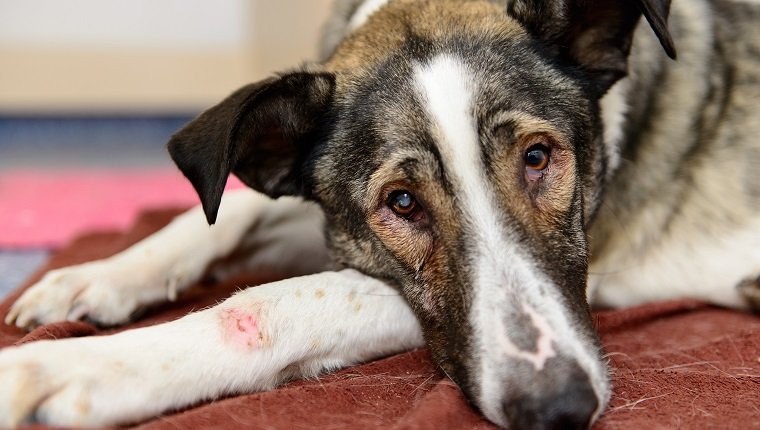Abscesses in dogs are pockets of pus somewhere in the body, commonly including the skin, mouth, between the toes, or within the body cavity. There are many types of abscesses in dogs, and they can range from small and superficial to large and dangerous.
Usually they appear in dogs as points of sudden, painful swelling that can be firm to the touch or soft and jelly-like. However, others form internally or deep within the tissue and don’t appear on the outside of the skin. Abscesses can also rupture and leak a bad-smelling, pus-filled fluid.
If you see signs of an abscess in your dog, then you must consult your veterinarian for a diagnosis and treatment. Here’s what you should know about the causes, symptoms, and treatment of abscesses in dogs.
Causes Of Abscesses

Abscesses have many potential causes but typically form when a wound becomes infected with bacteria. Abscesses form in response to these bacteria when a wound goes untreated.
Pasteurella multocida is the bacteria that most commonly causes skin infections in dogs. Staphylococcus intermedius is another bacteria that causes abscesses, and it can usually be treated with ointments.
Injuries that commonly get infected with bacteria resulting in abscesses include wounds in the mouth from sharp objects, bite wounds from other animals, and ingrown hairs.
Certain breeds have a predisposition to developing abscesses. These include the Chinese Shar-Pei, English Bulldog, and Labrador Retriever, all of which have short, stiff hairs that can get pushed back into the hair follicles and become infected, resulting in abscesses between the toes.

Outdoor dogs are also more susceptible to abscesses.
Skin, mouth, and lung injuries are more common in competitive or outdoor dogs because they have more opportunities to come into contact with sharp, dirty objects or to swallow or inhale grass awns, which are sharp seeds that can dig into tissue.
Dogs who have not been neutered or spayed also tend to develop abscesses because they are more likely to fight with other animals and get bite wounds. Furthermore, older male dogs who haven’t been neutered are at higher risk of prostate disease, which can result in prostate abscesses, and un-spayed older females are at higher risk of mammary gland infections that can result in abscesses.
Other causes include impacted anal sacs, blood infections that result in liver abscesses, tooth damage that can cause root abscesses, and ear, sinus, or mouth infections that can cause brain abscesses.
Almost any wound, even a small one, can become infected and cause an abscess in the body.
Symptoms Of Abscesses

There are many potential symptoms that can appear with an abscess. Your vet will be able to take a swab and a blood test to determine which type of bacterial infection is causing it and whether that infection has moved to the bloodstream.
Here are some signs of an abscess that you should look out for:
- Pain, inflammation, swelling, and redness at the site
- Heat coming from the site
- Appetite loss
- Fever
- Lethargy
- Excessive licking or chewing of the site
- Hair loss at the site
- Bleeding or oozing around the wound
- Black or putrid smelling skin (when left untreated)
Other specific signs may show up based on the location of the infection.
A dog with a wound from infected anal sacs, for example, might scoot their bottom on the ground. A dog with a pulmonary abscess might show signs like coughing or difficulty breathing.
Internal abscesses are difficult to diagnose without veterinary tests and instruments, and they may result in few, if any, outward signs.
Treatment For Abscesses

Most external abscesses can be treated by a veterinarian as an easy, out-patient procedure. This treatment usually includes lancing the abscess for proper drainage or surgically removing it.
Occasionally anesthesia will be necessary. Antibiotics are a must to help fight off and prevent further infection.
Anti-inflammatory drugs may also be prescribed to reduce swelling. The site of the abscess should be monitored to ensure proper healing, and a follow-up veterinary exam will likely be required later.
A vet may recommend an Elizabethan collar or bandages to prevent licking an chewing. You may also wish to use topical ointments or solutions for future skin issues to prevent infection.
For some abscesses, your veterinarian may use more specific treatment.
Tooth root abscesses, for instance, can be treated by pulling the affected tooth or performing a root canal. Lung, liver, and pancreatic abscesses may require surgery. Infected anal sacs may also be surgically removed.
Vets can remove most abscesses without further complications, though internal abscesses that rupture can spread bacteria to other organs and parts of the body. This is why it is important to treat abscesses quickly and thoroughly.
Has your dog ever had an abscess? What kind of treatment did your vet recommend? Let us know in the comments below.





